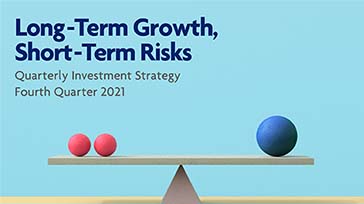
After an unprecedented 2020, we ask Anthony Raza, Senior Director and Head of Multi-Asset Strategy, whether 2021 unfolded in line with expectations and what, if any, were the lessons learnt
Tony, what were your thoughts as we entered 2021?
I would say that my overwhelming feeling was one of relief that vaccine programmes were underway in many countries, albeit some faster than others. Where global equity markets were concerned, they had already been gradually recovering from the pandemic shock. In fact, by the start of 2021, the MSCI ACWI had regained all its lost ground and more.
Given that the pandemic was still present in many countries, was this optimism justified?
Yes, I think so. Looking at the fundamentals, it was clear to us that global economic activity was starting to recover, helped by low interest rates. But we felt that the vaccine rollout would spur a new level of globally-synchronised growth and market upside.
This led us to call for an overweight in riskier assets such as high yielding assets equities, especially those in China. We had a neutral position on bonds, and were particularly cautious on government bonds. And as we were looking for maximum investment exposure, we were strongly underweight cash.
Going into the second quarter, did you think that there was a lot of steam left in the system?
The second quarter saw such good economic growth numbers that economists started to revise up their GDP forecasts. At the time the US Fed projected 2021 growth to come in at 5.8 – 6.6 percent, a stunning reversal from the – 3.4 percent in 2020. In fact, growth was so robust that we started to watch for signs of overheating that would result in inflation and higher long term bond yields.
While we continued to overweight equities and other riskier assets, we noted that Asian outperformance was starting to slow due to rising bond yields. Nevertheless, given our modest forecasts for bond yields in the second half of 2021, we continued to favour China, Singapore, Malaysia and Indonesia.
So the first half of the year was a happy one for investors. Did that continue into the second half?
As we moved into the third quarter, we could see that global economies were still expanding but markets were starting to show signs of fatigue. We warned that markets would struggle to adjust to a more normalised recovery mode and that strong earnings had already been priced in. Conscious of the potential for short term corrections, we took steps to shift to a neutral position on equities and fixed income.
That said, given our medium term positive outlook on risk assets, our strategy was to buy into periods of consolidation and we remained strongly underweight in cash. This was also reflected in our approach to Asian assets. In particular, we noted that regulatory tightening had the potential to dampen the Chinese market.
Now that we are in the closing weeks of 2021, what would you say were the biggest surprises of the year?
Given the circumstances that led to the 2020 recession, for which there is no equivalent in modern history, it is perhaps surprising that 2021’s recovery in company earnings and retail demand has been fairly textbook. Economic and market trends appear to be following a typical pattern of a mid-cycle expansion which would tend to favour equities over bonds. However, I would point to two issues that investors should note.
The first is that there is a fairly large divergence between the outlook that equity markets are pricing in versus bond markets. Equity markets appear to support continued expansion and reflation. But the persistence of low bond yields seems to imply that bond markets are less convinced about continued growth and inflation going into next year. These types of divergences usually reconcile over time, and we continue to lean into equities over bonds. But they do put us on the lookout for uncertainties.
Secondly, the repercussions of China’s Common Prosperity policies has challenged the wider investment community this year. The many factors at play, including the extent of the measures, the health of company balance sheets, and the potential spillover effects, means bottom up research is of the utmost importance.
UOBAM’s 1Q 2022 Investment Strategy report will be released early next year, but can you give us a preview?
Interestingly, we are ending the year as we began it – caught in a mix of hope and uncertainty about the Omicron variant. But even if the outcome of this new health scare is a positive one, we cannot expect a repeat of 2021. Instead, higher prices, the ending of supportive, fight-Covid policies, and the raising of interest rates will start to take effect next year.
In effect, 2022 will mark a more mature phase of global economic recovery that is accompanied by increased market volatility and lower earnings growth. However, for longer term investors, we anticipate the deepening of trends such as sustainability, digital transformation and Asian demographics to drive new, selective opportunities. We will elaborate more on this next year, but until then, a very Happy New Year to all.
This publication shall not be copied or disseminated, or relied upon by any person for whatever purpose. The information herein is given on a general basis without obligation and is strictly for information only. This publication is not an offer, solicitation, recommendation or advice to buy or sell any investment product, including any collective investment schemes or shares of companies mentioned within. Although every reasonable care has been taken to ensure the accuracy and objectivity of the information contained in this publication, UOB Asset Management Ltd ("UOBAM") and its employees shall not be held liable for any error, inaccuracy and/or omission, howsoever caused, or for any decision or action taken based on views expressed or information in this publication. The information contained in this publication, including any data, projections and underlying assumptions are based upon certain assumptions, management forecasts and analysis of information available and reflects prevailing conditions and our views as of the date of this publication, all of which are subject to change at any time without notice. Please note that the graphs, charts, formulae or other devices set out or referred to in this document cannot, in and of itself, be used to determine and will not assist any person in deciding which investment product to buy or sell, or when to buy or sell an investment product. UOBAM does not warrant the accuracy, adequacy, timeliness or completeness of the information herein for any particular purpose, and expressly disclaims liability for any error, inaccuracy or omission. Any opinion, projection and other forward-looking statement regarding future events or performance of, including but not limited to, countries, markets or companies is not necessarily indicative of, and may differ from actual events or results. Nothing in this publication constitutes accounting, legal, regulatory, tax or other advice. The information herein has no regard to the specific objectives, financial situation and particular needs of any specific person. You may wish to seek advice from a professional or an independent financial adviser about the issues discussed herein or before investing in any investment or insurance product. Should you choose not to seek such advice, you should consider carefully whether the investment or insurance product in question is suitable for you.





